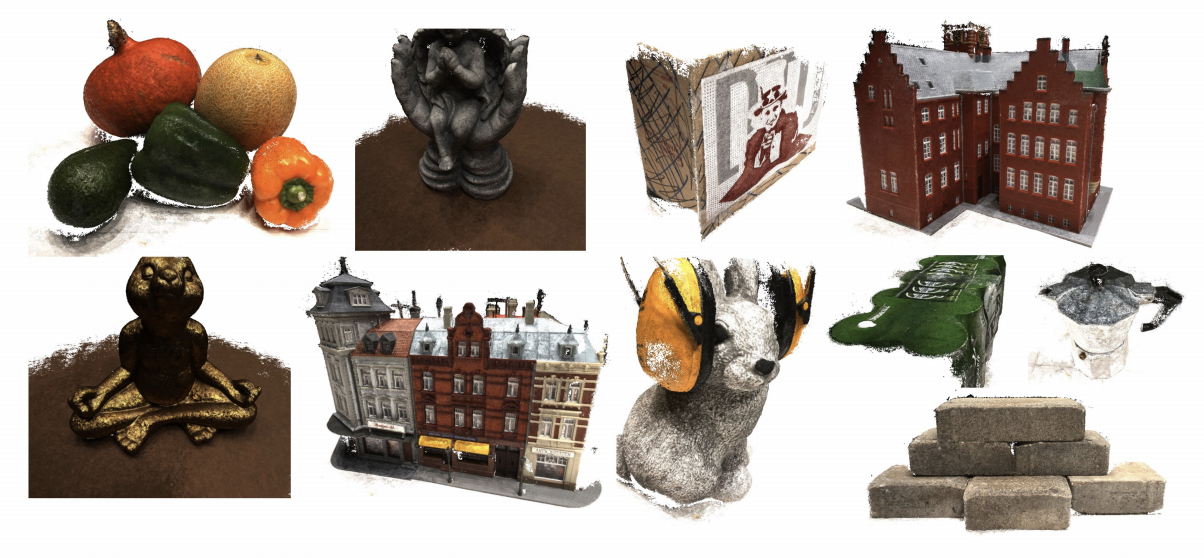Deep Stereo using Adaptive Thin Volume Representation with Uncertainty Awareness, CVPR 2020. (Oral Presentation)
UCSNet is a learning-based framework for multi-view stereo (MVS). If you find this project useful for your research, please cite:
@inproceedings{cheng2020deep,
title={Deep stereo using adaptive thin volume representation with uncertainty awareness},
author={Cheng, Shuo and Xu, Zexiang and Zhu, Shilin and Li, Zhuwen and Li, Li Erran and Ramamoorthi, Ravi and Su, Hao},
booktitle={Proceedings of the IEEE/CVF Conference on Computer Vision and Pattern Recognition},
pages={2524--2534},
year={2020}
}
reconstruction results on DTU dataset:
- python 3.6 (Anaconda)
pip install -r requirements.txt
- Download pre-processed testset: Tanks and Temples and DTU. Each dataset should be organized as the following:
root_directory
├──scan1 (scene_name1)
├──scan2 (scene_name2)
├── images
│ ├── 00000000.jpg
│ ├── 00000001.jpg
│ └── ...
├── cams
│ ├── 00000000_cam.txt
│ ├── 00000001_cam.txt
│ └── ...
└── pair.txt
- In
scripts/test_on_dtu.shorscripts/test_on_tanks.sh, setroot_pathto dataset root directory, setsave_pathto your directory - Test on GPU by running
bash scripts/test_on_dtu.shorbash scripts/test_on_tanks.sh - For testing your own data, please organize your dataset in the same way, and generate the data list for the scenes you want to test. View selection is very crutial for multi-view stereo. For each scene, you may also need to implement the view selection in
pair.txt:
TOTAL_IMAGE_NUM
IMAGE_ID0 # index of reference image 0
10 ID0 SCORE0 ID1 SCORE1 ... # 10 best source images for reference image 0
IMAGE_ID1 # index of reference image 1
10 ID0 SCORE0 ID1 SCORE1 ... # 10 best source images for reference image 1
...
- Download the modified fusibile:
git clone https://github.com/YoYo000/fusibile - Install by
cmake .andmake - In
scripts/fuse_dtu.shorbash scripts/fuse_tanks.sh, setexe_pathto executable fusibile path, setroot_pathto the directory that contain the test results, settarget_pathto where you want to save the point clouds. - Fusing by running
bash scripts/fuse_dtu.shorbash scripts/fuse_tanks.sh
Note: For DTU results, the fusion is performed on an NVIDIA GTX 1080Ti. For Tanks and Temple results, the fusion is performed on an NVIDIA P6000, as fusibile requires to read in the depth maps all in once, you may need a GPU with memory around 20GB. You can decrease the depth resolution in previous computing step or try our implementation for depth fusion
- Install NVIDIA apex for using Synchronized Batch Normalization
- Download pre-processed DTU training data from MVSNet, and download our rendered full resolution ground-truth. Place the ground-truth in root directory, the train set need to be organized as:
root_directory
├──Cameras
├──Rectified
├──Depths_4
└──Depths
- In
scripts/train.sh, setroot_pathto root directory, setnum_gpusto the number of GPU on a machine (We use 8 1080Ti in our experiments). - Training:
bash scripts/train.sh
UCSNet takes the MVSNet as its backbone. Thanks to Yao Yao for opening source of his excellent work, thanks to Xiaoyang Guo for his PyTorch implementation MVSNet_pytorch.
